White slave propaganda
White slave propaganda was a kind of publicity, especially photograph and woodcuts, and also novels, articles, and popular lectures, about biracial and pure white slaves.[1] Their examples were used during and prior to the American Civil War to further the abolitionist cause and to raise money for the education of former slaves.
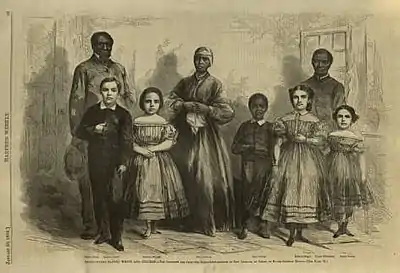
The images included children with predominantly European features photographed alongside dark-skinned adult slaves with typically African features. All these people, including the seemingly white children, were classified as black under the one-drop rule, as they had both black and white ancestry. It was intended to shock the viewing audiences with a reminder that slaves shared their humanity, and evidence that slaves did not belong in the category of the "Other".
Historical background
Sexual exploitation of slaves by their masters, master's sons, overseers, or other powerful white men was common in the United States. (See Children of the plantation.) By the 1860 Census, mixed-race slaves constituted about 10% of the 4 million slaves enumerated; they were more numerous in the Upper South. Slavery had existed for a longer time there, and in the generally smaller holdings, slaves had lived more closely with white workers and masters, leading to more contact between the groups. The scale of the sexual exploitation is suggested by research that show the DNA of contemporary African Americans is, on average, 24% European in origin.[2]
An analysis of the WPA Slave Narrative Collection, collected in the 1930s, shows that, when women discussed parentage at all, about one-third of these women ex-slaves said they had given birth to a child with a white father, or were themselves the child of a white father.[3] The plight of these mixed-race slaves, especially as children, was often publicized as a way to further the abolitionist cause.
Some pro-slavery activists wanted slavery legalized nationwide, overruling state prohibitions. They suggested there was no reason why slavery should be limited to blacks. They said that Northern white laborers would actually have better lives as slaves.[4]
Abolitionist use of "white slaves"
Fiction
The first abolitionist novel,[5] The Slave: or Memoirs of Archy Moore, published in 1836 by historian Richard Hildreth, features an enslaved mixed-race hero, son of a white planter and an enslaved mother, who is herself the daughter of a white planter. He can state that "both on the father's and the mother's side, I had running in my veins, the best blood of Virginia".[6] When he and his sister decide to escape, they have no problems "in passing ourselves as white citizens."[7] The title of the 1852 edition refers to the appearance of the hero: The White Slave; or, Memoirs of a Fugitive.[8]

The character of Eliza in the 1852 novel Uncle Tom's Cabin was described as a quadroon slave (one-quarter black ancestry), whose child also appeared to be "all-but-white".[9][10]
Another popular abolitionist novel of the time was Mary Hayden Pike's Ida May: a Story of Things Actual and Possible (1854), a story about a "white" slave. In 1855, Mary Mildred Botts, a young mixed-race slave who appeared white, gained freedom after her father got financial support from abolitionists to purchase her freedom as well as that of his wife and two other children. Among those who helped was US Senator Charles Sumner of Massachusetts, who adopted her. She was considered the embodiment of Ida May. Articles were published about her in the Boston Telegraph and the New York Times, and copies of her photograph were widely publicized.[11][12][13] Botts accompanied Sumner and other abolitionists on stage; she sat with them while they lectured, and was described as a former slave. On May 19 and 20, 1856, Sumner spoke in the Senate, comparing Southern political positions to the sexual exploitation of slaves then taking place in the South. Two days later Sumner was beaten almost to death on the floor of the Senate in the Capitol by Representative Preston Brooks from South Carolina, known as a hothead.[13]
Three decades after the Emancipation Proclamation, Frances Harper's 1892 novel Iola Leroy, or Shadows Uplifted tells the story of a "colored" family before and after emancipation. With the exception of Iola's grandmother, who is "unmistakably colored",[14] all members of the family have so much European ancestry that they can easily pass for white. When Iola's uncle, Robert Johnson, escapes from slavery and distinguishes himself in the Union army, a white officer compares him to the other former slaves among his soldiers: "You do not look like them, you do not talk like them. It is a burning shame to have held such a man as you in slavery." Johnson answers: "I don't think it was any worse to have held me in slavery than the blackest man in the South."[15]
Nonfiction
Nonfiction accounts written by escaped mixed-race slaves who used their European appearance to "pass for white" and gain freedom include Ellen Craft: Running a Thousand Miles for Freedom (coauthored with her husband William).[16] With majority-white ancestry, Craft often also appeared as a speaker on the abolitionist lecture circuit.[17]
The Crafts and other abolitionists also publicized the life of Salomé Müller, a German immigrant orphaned as an infant soon after arrival in New Orleans. Though Muller (later known as Sally Miller) was completely of European descent, she became enslaved as an infant, and was assumed to be a mixed-race slave. The threat of white girls being seized and thrown into slavery prompted Parker Pillsbury to write to William Lloyd Garrison: "A white skin is no security whatsoever. I should no more dare to send white children out to play alone, especially at night...than I should dare send them into a forest of tigers and hyenas."[18]
Fannie Virginia Casseopia Lawrence was a young white slave freed in early 1863. She was adopted by Catherine S. Lawrence of New York and baptized by Henry Ward Beecher at the Plymouth Congregational Church in Brooklyn, New York. Carte de visite photographs of her were also sold to raise money for the abolitionist cause.[19]
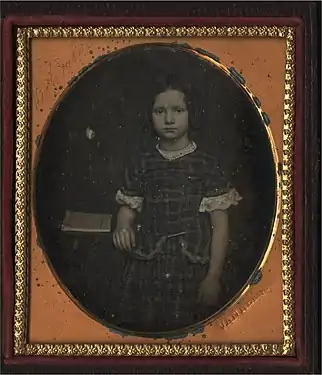 Mary Mildred Botts/Williams in an 1855 daguerreotype
Mary Mildred Botts/Williams in an 1855 daguerreotype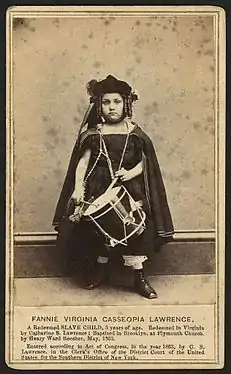 Fannie Virginia Casseopia Lawrence, a slave freed in early 1863
Fannie Virginia Casseopia Lawrence, a slave freed in early 1863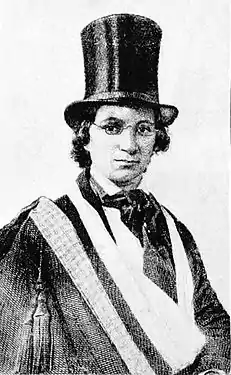 Etching of Ellen Craft, based on a c. 1860 photo
Etching of Ellen Craft, based on a c. 1860 photo
A special case: Freed slaves from Louisiana
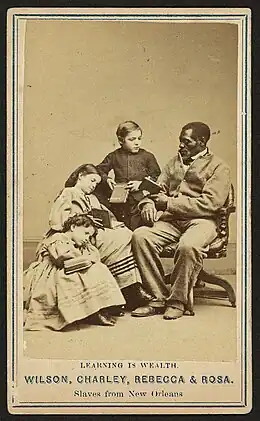
By 1863 in Louisiana, ninety-five schools for freedmen, serving 9,500 students, were active in areas controlled by the Union Army. Funding was needed to continue to run the schools. The National Freedman's Association, the American Missionary Association, and Union officers launched a publicity campaign to raise money by selling carte de visite (CDV) photographs of eight former slaves, five children and three adults. The former slaves were accompanied on a tour of Philadelphia and New York by Colonel George H. Hanks. A woodcut, based on a photograph of the former slaves, appeared in Harper's Weekly in January 1864 with the caption "EMANCIPATED SLAVES, WHITE AND COLORED."[20][10] Four of the children were predominantly white in appearance, although born into slavery.
The former slaves traveled from New Orleans to the North. Of these, four children appeared to be white or octoroon. According to the Harper's Weekly article, they were, "'perfectly white;' 'very fair;' 'of unmixed white race.' Their light complexions contrasted sharply with those of the three adults, Wilson, Mary, and Robert; and that of the fifth child, Isaac—'a black boy of eight years; but nonetheless [more] intelligent than his whiter companions.'"[20][21]
The group was accompanied by Colonel Hanks from the 18th Infantry Regiment. They posed for photos in New York City and in Philadelphia. The resulting images were produced in the carte de visite format and were sold for twenty-five cents each, with the profits of the sale being directed to Major General Nathaniel P. Banks back in Louisiana to support education of freedmen. Each of the photos noted that sale proceeds would be "devoted to the education of colored people".[20][21]
Of the many prints that were commissioned, at least twenty-two remain in existence today. Most of these were produced by Charles Paxson and Myron Kimball, who took the group photo that later appeared as a woodcut in Harper's Weekly. A portrait of Rebecca was taken by James E. McClees of Philadelphia.[20]
Modern analysis

Modern scholars have examined the white slave campaign's motives and success. Mary Niall Mitchell, in "Rosebloom and Pure White, Or So It Seemed",[22] argues that because the slaves were depicted as being white, through both their skin color and style of dress, abolitionists could argue that the Civil War was independent of class status. Supporters of the war believed that this was needed after the draft riots in New York City that year. Predominantly ethnic Irish mobs had protested the draft law, as wealthier men could buy substitutes rather than serve in the war.
Carol Goodman, in "Visualizing the Color Line", has argued that the photos alluded to physical and sexual abuse of the children's mothers. When publishing the photo of the eight former slaves, the editor of Harper's Weekly wrote that slavery permits slave-holding "'gentlemen' [to] seduce [the] most friendless and defenseless of women." The specter of "white" girls being sold as "fancy girls" or concubines in Southern slave markets may have caused Northern families to fear for the safety of their own daughters. Similarly, the idea that white slave-master fathers would sell their own children in slave markets raised Northerners' concerns.
Gwendolyn DuBois Shaw, in "Portraits of a People", has argued that the usage of props, such as the American flag and books, helped to provide context for Northern viewers, and also to emphasize that the purpose of the photos was to raise money for education of former slaves by funding schools in Louisiana. She also noted that the use of "white" children to illustrate the damage caused by institutional slavery, whose victims were overwhelmingly visibly people of color, demonstrated the contemporary racism of both Southern and Northern societies.[20]
See also
- Julia Chinn, common-law wife of vice president Richard Mentor Johnson
- Wilson Chinn
- Sally Hemings, whose children are generally regarded as having been fathered by president Thomas Jefferson
- Irish slaves myth
- Garafilia Mohalbi, a Greek girl rescued from slavery in the Ottoman Empire
- Louisa Picquet
- Passing (racial identity)
- White slavery
- Mary Mildred Williams
References
Notes
- "The Young White Faces of Slavery". 30 January 2014.
- Lizzy Wade (18 December 2014). "Genetic study reveals surprising ancestry of many Americans". Science. Retrieved 11 October 2021.
The average African-American genome, for example, is 73.2% African, 24% European, and 0.8% Native American.
- "Free at Last? Slavery in Pittsburgh in the 18th and 19th Centuries". University Library System. University of Pittsburgh. 2009. Retrieved July 7, 2016.
- Nye, Russel B. (Summer 1946). "The Slave Power Conspiracy: 1830–1860". Science & Society. 10 (3): 262–274. JSTOR 40399768.
- Tenzer, Lawrence Raymond (1997). The Forgotten Cause of the Civil War: A New Look at the Slavery Issue, Chapter III. Scholars' Publishing House.
- The Slave: or Memoirs of Archy Moore, p. 19, retrieved 2020-04-12
- The Slave: or Memoirs of Archy Moore, p. 62, retrieved 2020-04-12
- The White Slave; or, Memoirs of a Fugitive, p. 62, retrieved 2020-04-12
- Stowe, Harriet Beecher (1852). Uncle Tom's Cabin. George Routledge & Company. p. 20. Retrieved July 5, 2016. See, in particular, Chapter II
- Goodman, Carol. ""As White As Their Masters": Visualizing the Color Line". mirrorofrace.org. Retrieved July 5, 2016.
- "A White Slave from Virginia". New York Times. March 9, 1855. Retrieved July 5, 2016.
- Gage, Joan. "A White Slave Girl "Mulatto Raised by Charles Sumner"". Mirror of Race. Retrieved July 5, 2016.
- Morgan-Owens, Jessie (February 19, 2015). "Poster Child: There's Something About Mary". Massachusetts Historical Society. Retrieved July 6, 2016.
- Iola Leroy, or Shadows Uplifted, p. 206, retrieved 2020-04-13
- Iola Leroy, or Shadows Uplifted, p. 44, retrieved 2020-04-13
- Craft, William and Ellen (1860). Running a Thousand Miles for Freedom. p. 63. ISBN 9781625585325. Retrieved July 6, 2016.
- Barbara McCaskill, "William and Ellen Craft", New Georgia Encyclopedia, 2010, accessed July 6, 2016
- Carol Wilson, "Sally Muller, the White Slave", Louisiana History, Vol. 40, 1999, accessed July 7, 2016
- Brown, Tanya Ballard (December 10, 2012). "A Black And White 1860s Fundraiser". NPR. Retrieved July 5, 2016.
- Caust-Ellenbogen, Celia. "White Slaves". Bryn Mawr College, Swarthmore College. Retrieved 11 July 2013.
- "'White' slave children of New Orleans". New York Daily News. 21 September 2012. Retrieved 31 August 2013.
- Mitchell, Mary Niall. "'Rosebloom and Pure White,' Or So It Seemed". ScholarWorks@UNO. University of New Orleans. Retrieved June 29, 2016. also published in American Quarterly 54:3 (September 2002): 369-410
Further reading
- Tenzer, Lawrence Raymond (1997). The Forgotten Cause of the Civil War: A New Look at the Slavery Issue. Scholars' Publishing House. ISBN 9780962834806. See especially Ch.III
- Fremont Campaign Literature, 1856
- Henry Louis Gates, Jr., Exactly How ‘Black’ Is Black America?
- Janken, Kenneth Robert (2006). Walter White: Mr. NAACP. UNC Press Books. pp. 3–5. ISBN 9780807857809.
External links
![]() Media related to White slave propaganda at Wikimedia Commons
Media related to White slave propaganda at Wikimedia Commons
![]() Works related to The Barbarism of Slavery at Wikisource
Works related to The Barbarism of Slavery at Wikisource